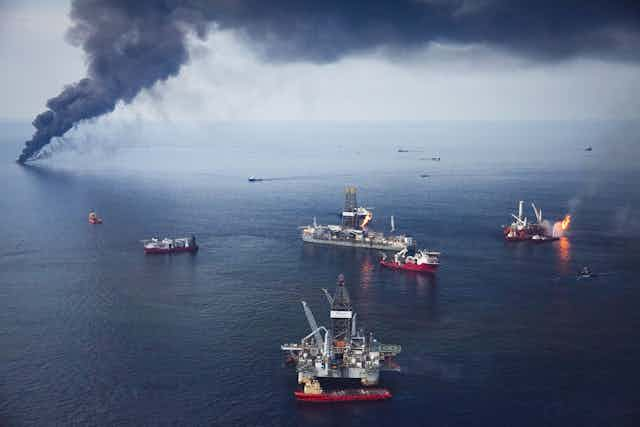Australia’s offshore petroleum industry regulator is set to rule next week whether to grant oil giant BP’s application to drill in the Great Australian Bight.
But BP’s environmental plan, released last week, suggests that the company’s proposed plan for dealing with a blowout displays less urgency than would be expected in some other parts of the world.
If a blowout does occur, BP proposes to cap it with a piece of equipment known as a capping stack. These devices did not exist at the time of BP’s Gulf of Mexico blowout in 2010, when a capping strategy had to be developed on the run, which is why it took 87 days to cap that well.
Since then, capping stacks have been designed, constructed and located strategically around the world. For its proposed operations in the Bight, BP would have access to a capping stack in Singapore. It would take up to 35 days to bring this stack to the Bight and cap the well.
The company has rejected the suggestion that a capping stack be located locally. It claims that the time needed to transport the device from Singapore to the Bight is not a critical issue. In its earlier environmental plan, released last October, BP said that capping a blowout would require significant preparatory work, by which time the Singapore capping stack would have arrived.
Yet the idea of spending more than a month to plug a flowing well hardly seems compatible with avoiding major environmental damage. According to BP’s own estimate, oil from a spill in the Bight could reach the shore in as little as nine days.
A recent exercise in the Gulf of Mexico shows that a blowout could be capped in 15 days, using a locally available capping stack. In this respect, BP’s estimate of the time it would take to cap a blowout is a long way short of industry best practice.
Whether or not travel time from Singapore is the critical issue, it is worth noting that there are five different capping stacks available for use in the Gulf of Mexico and three for use in UK waters. The expectation is that these stacks could be on site within 24-48 hours.
Note also that new rules imposed by the US regulator for drilling in the Arctic require that a capping stack be located within 24 hours’ travel time of the drill site. If the Arctic justifies this level of protection, why not the Bight?
Drilling a relief well
Should the capping strategy fail for any reason, BP has a backup plan for stopping the flow. This is to drill a relief well to intersect the blowout well below the sea floor and “kill” it by pumping it full of heavy fluid or cement.
The question this raises is: where would BP find a spare drilling rig to carry out this operation? After the Montara blowout off Western Australia in 2009, a suitable drilling rig was located near Singapore. But this rig would have been no use in the deep water of the Bight.
Oil companies operating in Australian waters have a memorandum of understanding among themselves to provide a suitable drilling rig in an emergency. Yet it remains unclear how easy it would be for another company to release a rig quickly for this purpose. As such, BP has assumed that it will take up to 149 days to acquire an appropriate rig, drill a relief well and plug the blowout.
The new Arctic regulations require that a relief rig be available nearby, to guarantee that a relief well can be drilled before winter sea ice moves in. The situation in the Bight is not as constrained by the seasons, but even so, 149 days seems an unacceptably long time to plug a well.
The Gulf of Mexico blowout was stopped in 87 days, during which time it inflicted damage worth at least A$40 billion. Who knows what the toll would have been if it had lasted almost twice as long?
Protecting the shore
Finally, BP has various strategies for reducing the amount of oil reaching the shoreline in the event of a spill. These include using dispersant chemicals, both subsea, at the point of release, and on the sea surface. The company puts particular emphasis on subsea dispersal, but recognises that this strategy would also be subject to delay.
It estimates that subsea dispersal would begin within 10 days “where that is possible”. This can never be a fully effective way to prevent coastal pollution, because BP’s modelling suggests oil would begin arriving on the coast in less time than this.
BP has also noted that traditional methods of containment and recovery of oil using booms and skimmers “are not expected to provide significant benefit” in the open ocean.
What seems more likely in the event of a spill is that the company will find itself fighting a last-ditch battle against the oil as it approaches sensitive parts of the shoreline, and where this fails it will implement shoreline and oiled wildlife clean-up.
It is difficult to forecast any other scenario, given the time frames described in BP’s own documents. Its published response plan gives no guarantee that an oil spill in the Bight would not reach the shoreline and damage the environment.
Experience elsewhere in the world suggests that these timelines can be tightened. The question for the regulator is whether BP has reduced the risk to a level that is “as low as reasonably practicable”.
It is by no means obvious that the answer is yes.
Andrew Hopkins is the author of Disastrous Decisions: The Human and Organisational Causes of the Gulf of Mexico Blowout.

